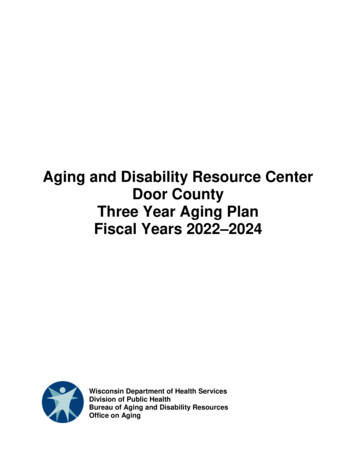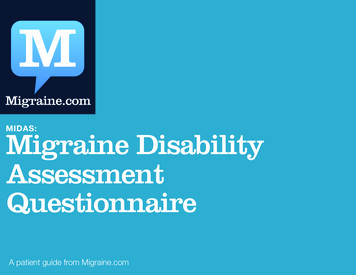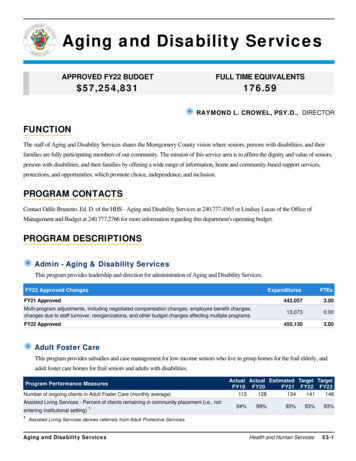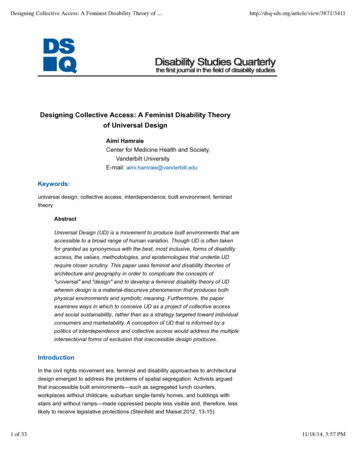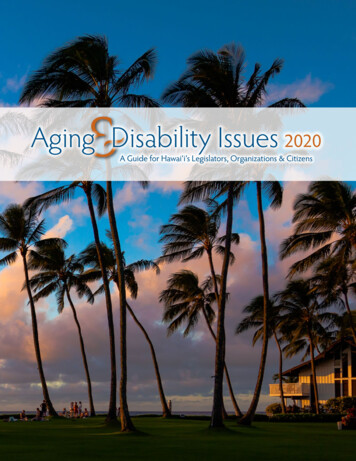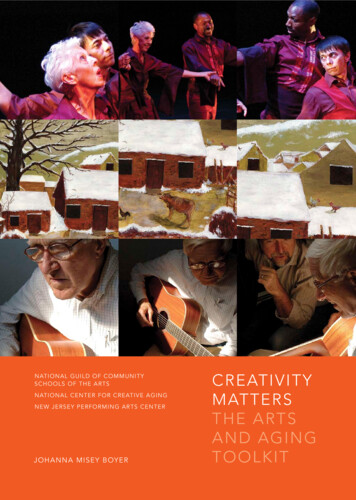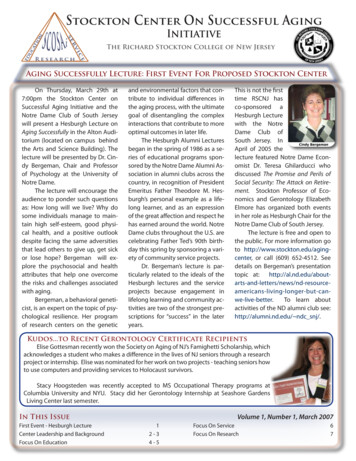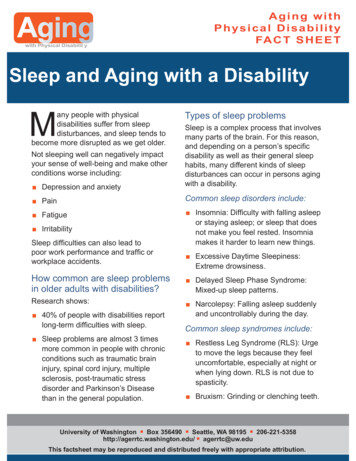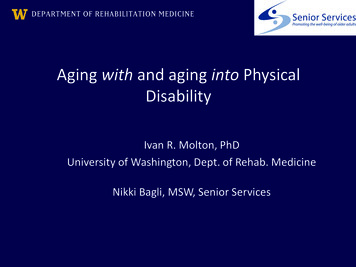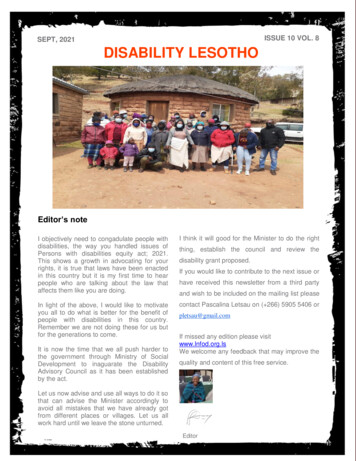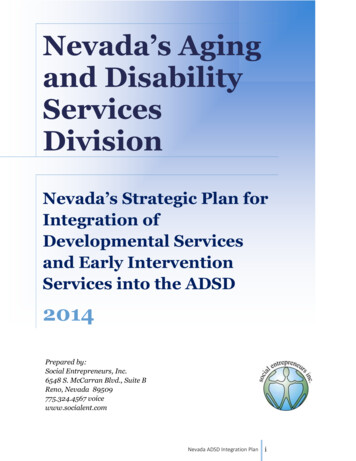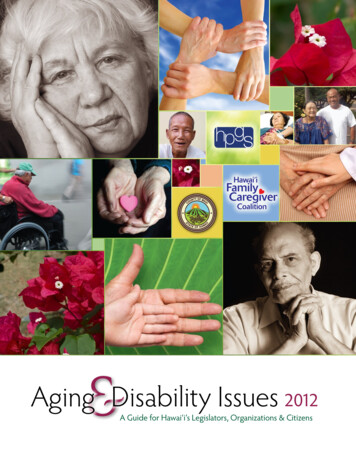
Transcription
&Aging Disability Issues 2012A Guide for Hawai‘i’s Legislators, Organizations & Citizens
Aging & Disability Issues 2012 is a joint project of the Hawai’i Family Caregiver Coalition, the Hawai’i Pacific Gerontological Society, and the Maui County Office On Aging.The Hawai‘i Family Caregiver Coalition wasformed to develop new partnerships at local and statelevels to advance a coordinated approach to address theneeds of Hawai‘i’s family caregivers. As caregiving touches everyone, the mission of the Hawai‘i Family CaregiverCoalition is to improve the quality of life of those whogive and receive care by increasing community awarenessof caregiver issues through continuing advocacy, education, and training.Over the years, the Hawai‘i Family Caregiver Coalitionhas supported our community by sponsoring the following projects: Holo Imua Kakou Legislative Reception Family Caregiver Awards Program – a joint venturewith KHON2’s Elderhood Project Aging and Disability Issues Report Family Caregiver Awareness Day and Resource Fair Family Caregivers Speakers’ BureauOrganized in 1979, the Hawai‘i Pacific Gerontological Society (HPGS) is a not-for-profit organization whose mission is “to provide professionals andstudents in the field of aging with vital information,workshops, networking, and scholarships to enhance thegerontology workforce, to support the creation of neededpolicies and programs, and to deliver excellent service tothe aging population in Hawai‘i and the Pacific.If you are a professional or non-professional, activelyretired or still employed, young or not so young, if you areengaged by the idea of creating a better Hawai‘i for ourelders, please accept this invitation to join the Hawai‘iPacific Gerontological Society now!Please visit the Hawai‘i Pacific Gerontological Societyonline at www.hpgs.org or mail your inquiry to:Hawai‘i Pacific Gerontological SocietyP.O. Box 3714Honolulu, Hawai‘i 96812 Family Caregiver’s Kit for BusinessesFor more information, please contact:The Hawai‘i Family Caregiver Coalitionc/o The Caregiver Foundation95-099 Lauaki PlaceMililani, Hawai‘i 96789Phone: (808) 625-3782Email: pacconltd@yahoo.comT he Maui County Office on Aging (MCOA) takesthe lead role in aging issues on behalf of the older personsin Maui County. As the designated lead agency at the local level, MCOA promotes and protects the well-being ofthe older person in Maui County. For more informationabout MCOA, please contact:Deborah Arendale, DirectorMaui County Office on Aging2200 Main Street Suite 547Wailuku, Maui, Hawai‘i 96793Phone: (808) 270-7774i
Table of Contents&Aging Disability Issues 2012A Guide for Hawai‘i’s Legislators, Organizations & CitizensSection 1Introduction: The Current Context & Fiscal Challenge . . . . . . . . . . . . . . . . . . . . . . . . . . . . . . . . . . . . . . . . . . . . . . . . . . . . . . . . . . . . . . . . . . . . . . 1Section 2Review of Policies & Programs: Priorities of the Aging Network . . . . . . . . . . . . . . . . . . . . . . . . . . . . . . . . . . . . . . . . . . . . . . . . . . . . . . . . . . . . . 5Section 3Review of Policies & Programs: Implementing the Long-Term Care Commission Recommendations . . . . . . . . . . . . . . . . . . . . . . . . . . . 8Section 4Review of Kupuna Caucus & Other Policies & Programs Important to Aging & Disability Issues . . . . . . . . . . . . . . . . . . . . . . . . . . . . . . 10Section 5Information, Education & Research Resources . . . . . . . . . . . . . . . . . . . . . . . . . . . . . . . . . . . . . . . . . . . . . . . . . . . . . . . . . . . . . . . . . . . . . . . . . . . . . 12Aging & Disability Issues 2012Report Production &Editorial CommitteeEldon WegnerTony LenzerWes LumCoordinator of CaregiverStories & PhotosDeborah ArendaleGraphic DesignJason Y. Kimura CommunicationsInside Cover (opposite)About the Hawai‘i Family Caregiver Coalition,the Hawai‘i Pacific Gernontological Society, andthe Maui County Office on Agingii
Section 1 - The Current Context & Fiscal ChallengeIntroduction:The Current Context& Fiscal ChallengeAAging & Disability Issues 2012 is theseventh annual publication that offersan overview of legislative issues dealing with aging, disability, caregiving,and long-term supports and services.The purpose is to call attention to thepriority issues which deserve the serious attention of our lawmakers, advocates, and the public. It is a joint project of the Hawai‘i Family CaregiverCoalition (HFCC), the Hawai‘i PacificGerontological Society (HPGS), andthe Maui County Office on Aging. Theirsupport is gratefully acknowledged.This report has five sections. Section 1 provides general backgroundby describing the current fiscal andpolitical context in Hawai‘i relevantto aging and disability issues andcurrent initiatives of the federal andstate governments in responding tothe needs of the elderly and personswith disabilities. The section alsodiscusses the challenge posed by thestate’s fiscal dilemmas, both shortand long-term, while coping with arapidly expanding older population,and describes the path our state administration and legislature intend tofollow to meet this challenge. The section concludes with principles whichwe believe should underlie politicaldecision-making by the administration and the Legislature.Sections 2, 3, and 4 discuss thepriority aging and disability issuesbefore the 2012 Legislative Session.Section 2 describes the legislativepriorities of the Aging Network andthe critical bills which address thesepriorities. Section 3 describes the recommendations of the Long-Term CareCommission for shaping the future oflong-term care in Hawai‘i and the billsintended to initiate implementation1of these recommendations. Section 4discusses the priority bills of the Kupuna Caucus and other bills which areimportant to aging and disability issues. Note that all of the bills in theseSections were still being consideredfor passage at the time this report waswritten. Readers interested in the fateof particular bills should consult theirrepresentative or senator’s office, orlook up the measure by number (e.g.,HB 1234) on the legislative website,www.capitol.hawaii.gov.People are most likely to be motivated to support public policies whenthey perceive that a problem may affect them personally. In addition to asummary of bills, Aging & DisabilityIssues 2012 includes personal storieswhich describe the difficulties any ofus could experience if faced with aging or disability. These stories providea human face to legislative issues byillustrating how these issues are embodied in the very human experiencesof individuals and families.Aging & Disability Issues 2012concludes with Section 5, which listsavailable information, education, andresearch resources relevant to agingand disability issues.The Current ContextThe year 2011 was the first year ofGovernor Abercrombie’s administration, with the promise of “A New Dayin Hawai‘i.” The continuing economicrecession and fiscal crisis, however,has meant continued reductions in the“safety net” of services for the elderly,as well as for other vulnerable populations. However, the state ended 2011with the first budget surplus in threeyears, and revenue is increasing as aconsequence of economic recovery.While the priority of the state willcontinue to be focused on economicrecovery, there is now promise forbetter times. In his 2012 State of theState message, Governor Abercrombienoted, “Seniors want to age in theircommunities; they want to age in theirhomes. But more importantly, theydeserve to do so. And they deserve todo so with dignity. That is why I amcommitted to strengthening our system of home- and community-basedservices. Their needs can no longer,and should no longer, be ignored.”1Positive changes are underway—typically outside of public view—to fulfillthe Governor’s promise to create a moreeffective and a more efficient state gov-
(continued)ernment. These efforts include reducingfragmentation between departmentsand consolidation of some responsibilities to increase effectiveness. An important example is a national effort to consolidate aging and disability programs.Over the years, separate bureaucraticprograms and funding streams havedeveloped for elders and for persons invarious categories of disability. Nevertheless, older adults and other personswith disabilities have similar problemsand require many of the same services.The U.S. Administration on Aging andCenters for Medicare and Medicaid Services provided initial funding for stateand county offices on aging to createAging and Disability Resource Centers(ADRC’s), which are designed to provideboth older citizens and other disabledadults a single access to the myriad ofavailable programs. These and other efforts at consolidation should greatly enhance the effectiveness and efficiency oflong-term care services for both elderlyand younger disabled persons.The Executive Office on Aging alongwith its partners in the aging and disability networks are undergoing a systems change to implement Aging andDisability Resource Centers in eachcounty. Other changes include the Community Living Program and personcentered Hospital Discharge Planninginitiatives. These initiatives are a significant change from the traditional way ofproviding services for people who needlong-term supports and services by empowering consumers through expanding their choices over who and how theywill receive needed care. The ExecutiveOffice on Aging has also secured federalfunding from the Lifespan Respite Pro-gram which supports informal caregiving and assistsindividuals to age in place. Anew four-year plan, Hawai‘iState Plan on Aging: October1, 2011–September 30, 2015,includes specific goals, objectives, a timetable, andmeasurable benchmarks.2When fully realized, theseinitiatives will greatly enhance care for disabled andelderly persons in Hawai‘i.The challenge is to mobilizethe political will to see theseprojects fully realized.Dealing with theFiscal DilemmaTwo critical realities set the stage for Aging & Disability Issues 2012. To somedegree, these realities stand in tensionwith one another. The first reality is thatthe older population is rapidly growing.On the one hand, enormous numbersof baby boomers are entering old age;these are the so-called “young old.” Onthe other hand, the “old old,” those 85and older, are also increasing very rapidly. In the year 2000 in Hawai‘i, the 85 population numbered less than 18,000.By 2010, this group was estimated to benearly 30,000, and by 2030, over 40,000of our citizens will be in this age group.3Persons over 85 pose the more immediate challenge to state government because they experience more illness anddisability, and place greater demands onpublic and private resources. For example, in 2000, whereas only 4.7% of persons 60 to 74 needed any personal assistance, 6.8% of those 75 to 84 neededassistance, and 22.1% of persons 85 andolder needed some personal care—morethan a three-fold increase.4The second reality is the financialcrisis affecting both the nation andalmost every state. This crisis has twoparts. First, both federal and stategovernments face immediate budgetcrises due to the economic recessionand declines in tax revenues whileSection 1there has been growing demand forservices by those suffering from therecession. In Hawai‘i, the state government is constitutionally requiredto have a balanced budget every year.While revenues have increased overthe past year, they still fall far short ofbeing able to restore the level of services prior to the recession, much lessto address the growing needs such asthe increasing number of elderly persons who need services. Second, theproblem is further compounded bythe unfunded liabilities the state facesin fulfilling its long-term obligation topay for the retirement and health carebenefits of public workers and retireesinto the future. In 2008, for example,Hawai‘i had an unfunded pension liability of about 5.2 billion and anunfunded obligation for the futurehealth care of public worker retireesof approximately 10.8 billion.5Unfortunately, the need to addressthe fiscal crisis is in tension with theneed to expand services to address thegrowing needs for eldercare, as well asfor other vulnerable groups. The Governor’s New Day Plan emphases economic recovery and growth as a key strategy for meeting this challenge, whichis to be realized through job growth,improving the economic foundationof the state, upgrading the workforcethrough investing and reforming education, and finally, through restructuring state government to be moreefficient and effective.62
Section 1 (continued)A Maui Caregiver Story:Pat and Alice .One Year LaterWe first met 82-year-olds Pat Park and Alice Martin in “Aging & Disabilities Issues 2011,” one year ago. Pat had just returned home from a rehabilitation facility due to removal of a brain tumor, and Alice was experiencing herfirst weeks of full-time caregiving after recently overcoming breast cancer.In the past 12 months, Pat and Alice have demonstrated a strong resolveto remain living independently and with dignity. They epitomize the situations that Kupuna Care services are designed to address. In spite of thehealth challenges and resulting physical limitations, Pat remains at home withAlice as her primary caregiver. With Alice by her side, Pat has progressedfrom being bed-ridden with around-the-clock care to using a wheelchair(occasionally a walker) and needing only basic services.In the last year, Kupuna Care services have assisted Pat to enjoy the opportunity to age in place. Currently, Pat and Alice receive home deliveredmeals, homemaker, and chore services. Due to the incline of their drivewayand the need for a vehicle that can accommodate a wheelchair, they supplement these services with private pay transportation services. Additionalcaregiver help has further supported these two very determined women.Pat asserts that since the women are “less than young,” they are deeplyappreciative of the services they receive. She also stated that when she considers the situation the women were in a year ago, there are “no complaints.”Both women acknowledge that through perseverance, they have adaptedand found a way to manage their situation. “We would have had a muchharder time adapting without the help of Kupuna Care services,” Pat stated.“It’s very hard to ask for help, but Maui County Office on Aging has made itvery easy to get the help we need to be as self-sufficient as possible.”Both women agree that “the one thing old people fear more than anything else is losing their independence.” Services such asKupuna Care, however, allow them to “still feel a semblance of independence.” Pat and Alice say that they have learned a lot in thelast year. Both women feel fortunate in spite of their current challenges. They are glad that they are a part of the “quiet minority inthe community of seniors who are benefiting daily from Kupuna Care services.”The women hope that those in decision-making positions will “listen and understand that there are many people who rely heavily on Kupuna Care Services that are kept alive and healthy by those services.” They believe that there is no way to put a price onthe benefits that these services provide every day.What is in the future for Pat and Alice? “I want to try to be even more independent,” insisted Pat of their future. “If you knowme and Alice, we’ll try everything!”The State administration and legislature are working to realize thesegoals, including by short-term stimulus to the economy through publicconstruction projects. In addition,3they seek to find ways to reduce expenses and raise revenues. Bureaucratic consolidation and improvements in technology are underwayto increase efficiency. Measures havebeen taken to create greater fairnessin the tax system, close tax loop holes,and eliminate or reduce tax exemptions to organizations and businesseswho can afford to contribute more.
(continued)Other measures to reform the pension system and worker benefits arealso being considered.This path is in sharp contrast to theoften expressed opinion that there isno choice but to reduce the role of government in providing health and social programs. While these measureswill take some time, our Governor andour legislature have shown their commitment to care for our vulnerabledisabled and elderly, and to find theresources which make this possible ina fiscally responsible manner.Principles for Political DecisionsThis section concludes by noting general principles which we believe shouldbe observed when the administrationand legislature face making difficultdecisions this year.Fiscal Measures Should Spreadthe Burden Across the EntirePopulation. In times of economicdownturn, the easiest response is to reduce public services to the most vulnerable citizens who depend upon theseservices to meet their basic needs. Webelieve that such measures typicallygenerate further social and healthproblems and are lacking in fairness.Instead, our tax system needs to be reformed to achieve greater equity and toincrease available revenue by spreadingthe burden to support essential stateservices across the entire population.Preserve the Safety Net of Homeand Community-Based Services.Unpaid family caregivers provide approximately 80% of the care of disabledand frail elderly individuals. Patientscared for in their homes have higher lifesatisfaction and higher levels of functioning than those placed in institutional environments. The public interestis best served by maintaining those programs that provide services to frail anddisabled persons in their homes and assist families in continuing to provide informal care. Reductions of such serviceswould likely result in greater dependenceon expensive institutional care.Develop Essential Public-Private Partnerships. Traditionally,the Aging Network has drawn mostheavily on federal and state resources.Many programs came into existence asa result of the federal Older AmericansAct of 1965. Forty-six years later, it isabundantly clear that, even under goodSection 1economic conditions, existing publicprograms cannot begin to meet allthe needs of today’s older population.These can be met only if and when theresources of the private sector are alsoengaged in this effort. Legislators andpublic programs must explore ways ofcreating working relationships withemployers, unions, faith communities,and philanthropists in addressing theissues faced by disabled and elderlypersons and their caregivers. Everyone has a shared responsibility to carefor our kupuna and for those who facedifficult challenges due to disabilities.References1Governor Neil Abercrombie, “Investing Nowfor Hawai‘i’s Future,” State of the State Address2012, January 23, 2012.Hawaii Executive Office on Aging, Hawai‘i StatePlan on Aging: October 1, 2011–September 30,2015, Honolulu, Department of Health, Hawai‘iState Government, 2011.23Hawai‘i Executive Office on Aging, Hawai‘i StatePlan on Aging: October 1, 2008 – 2011. Honolulu: Department of Health, Hawai‘i State Government, October 2007.4Hawai‘i Executive Office on Aging, Profile ofHawai‘i’s Older Adults and Their Caregivers,Hawai‘i Department of Health, January 2006.The Trillion Dollar Gap: Underfunded State Retirement Systems and the Roads to Reform. ThePew Center on the States. Washington, DC andPhiladelphia, PA: The Pew Charitable Trusts February, 2010.5Governor Neil Abercrombie, The New DayPlan, -plan 2012.64
Section 2 - Priorities of the Aging NetworkReview of Policies & Programs:Priorities of theAging NetworkHHawai‘i, along with many states,has undergone dramatic reductionsin revenue available for health andsocial programs. As in the past fewyears, maintaining funding for current programs is the priority of senioradvocacy organizations for this legislative session.An Extraordinary CaregiverKatherine is currently caring for her motherand her mother-in-law, although she retired fromthe DOE as principal of Hilo High School to carefor her then critically ill father. Her father passed10 months after she retired and he was Katherine’sfirst caregiving experience which led to her caringfor four other care recipients over five years.Kathy said Kupuna Care services made a bigdifference, and she is relieved that the case managers know the range of services available andhelp her understand the options as her lovedones’ needs change—and as their health declines and new issues arise. Having Kupuna Care services gave Kathy instant accessto professionals who could help her get information and access right away to helpwhen new needs arose.If she didn’t have Kupuna Care services for her care recipients, Kathy said shewould have a lot of stress and spend a lot more time and energy trying to get her family’s needs met. She also said Kupuna Care helped her as a caregiver to establish balance in her life by prioritizing taking care of herself while caring for her loved ones.Priorities in FundingCurrent ProgramsAging and Disability ResourceCenters (ADRC’s). Individuals andfamilies are typically caught unprepared by the onset of disability or serious disease. Only a small minority haveplanned who would provide care andhow they would pay for needed care.7Most individuals have no knowledge ofthe many agencies and programs thatmight be able to assist them or whereto turn for assistance. ADRC’s are designed to provide a single place forall persons with disabilities and theircaregivers to seek assistance and to ac-5cess the myriad of available programs.The creation of ADRC’s is an effort toreduce fragmentation and bureaucratic duplication. The Executive Office onAging is working with each county inimplementing a five-year plan to havefully functioning ADRC’s throughoutthe state. The state and counties needto assume responsibility for continuing their development and sustainingthem. Governor Abercrombie has proposed 1.4 million for ADRC development in the 2012 budget. SB 2779 provides the 1.4 million for the ADRCThe Kupuna Care Program. Kupuna Care provides home and community-based services for the non-Medicaid frail elderly. The Executive Officeon Aging allocates funds to the countyoffices on aging, which administer theprogram in their counties and contractfor services with private non-profitand for-profit agencies. Kupuna Careservices include personal care, choreservices, attendant care, case manage-ment, housekeeper, assisted transportation, home-delivered meals, and daycare programs. These services enablefrail and disabled persons to remain intheir homes and to delay or avoid enrollment in Medicaid and placementin expensive residential facilities. Theneed for these services is growing andwill continue to grow. The base budgetof 4.8 million has remained constantwhile the number of people who needservices is rapidly increasing. For thepast year, a 2010 appropriation fromthe Emergency Budget and ReserveFund helped reduce wait-lists. How-
(continued)ever, these funds will expire in June2012. An additional 4.2 million isneeded to sustain current levels ofservice during 2012-2013. These addi-Section 2Kupuna Care Bridges Gap for O‘ahu PairAn 89-year-old widow living on O‘ahu is the sole caregiver to her frail 80-year-oldbrother. He has difficulty walking, is hearing impaired, and has neurological problemswith both hands. They receive the following Kupuna Care services: meals and assistedtransportation to medical appointments, shopping and banking.tional funds would allow services foran additional 1,254 to 3,398 individuals depending upon their level impairment and targeted service need.SB 2320 appropriates funding for Kupuna Care services, the Healthy AgingPartnership program, senior centers,and elder registration services.SB 2659 appropriates moneys fromthe Emergency and Budget ReserveFund for Kupuna Care. SB 2320 is thepreferred bill, but this bill provides aDuring the time the caregiver was hospitalized after suffering a stroke, KupunaCare services were increased, and three volunteers stepped in to provide care forthe brother. If Kupuna Care services were stopped, this 80-year-old frail elder willnot have assistance with food or meal preparation, nor support with transportationto medical appointments, his bank, and grocery shopping. Both caregiver and carerecipient will not be able to live at home—a big dilemma. Without Kupuna Care services, both of these frail elders face institutionalization.backup source of funds.Healthy Aging Partnership. Athird priority for the 2012 Legislativesession is funding the Healthy AgingSon Puts ‘Ohana FirstFor the past seven years, Rueben Doronio haskept a promise made to his mother to come hometo Kaua‘i when she needed him. His mother taughthim that “‘ohana is always first.”With Kupuna Care services, Mr. Doronio worries less about his mother, who benefits fromhome-delivered meals and the social interactionshe receives. He is relieved that someone willcheck on his mother during the day when he isaway and he is glad that the meal delivery personbrightens his mother’s day. If Kupuna Care services were withdrawn, this caregiverwould worry that his mother was not eating well and whether she would be okaywhen he returned home.Partnership, which is part of a national initiative for older adults to participate in evidence-based health promotion programs. Reducing the incidenceof disability and serious health problems is far less costly than having toundergo complex treatments and having to receive long-term assistance.Unfortunately, funding for preventiveprograms typically receives low priority. Nevertheless, two programs havebeen initiated in Hawai‘i.The first is Better Choices, BetterHealth (Ke Ola Pono–Healthy Living), which is a chronic disease selfmanagement program. The programis a public-private partnership led bythe Executive Office on Aging withthe four Area Agencies on Aging, theDepartment of Health, and the University of Hawai‘i in partnership with40 service providers throughout thestate. From 2006 to 2011, there were6
Section 2(continued)1,542 graduates of this program statewide. An evaluation by University ofHawai‘i researchers found that graduates had decreased physician officevisits, hospitalizations, emergencyroom visits, reduced symptoms, andan increased number of days spentin physical activity. These outcomestranslate into significant health carecost savings.Kupuna Care AvertsDepression for MomRichard Wong is a 52-year-old caregiver to his mother, 75, living in Lahaina.The family benefits from Kupuna Careadult day care and adult day respiteservices for a total of six days a month.Before Kupuna Care services, Mrs.Wong stayed home alone every dayand became very withdrawn and depressed. She is doing really well withday care. Mr. Wong says his mothercomes alive when she arrives at day carewhere she has many friends. He saidher mood has improved even on thedays when she does not go to the daycare center. “I can see the difference,”said Mr. Wong. “She is more talkativenow; she can have a conversation.”The second program in the HealthyAging Partnership is Enhanced Fitness, which serves near-frail elderlypersons with the aim to improve theirhealth status and physical functioning through group exercise sessions.This program has been implemented ineight sites on the island of Kaua‘i andhad 291 graduates between 2006 and2011. The University of Hawai‘i evaluation of the program indicated graduateshad significantly reduced their numberof falls, improved upper body strength,and improved mobility and balance.These results suggest the program isimportant in reducing injuries and inenhancing overall health status.The modest 426,722 request is tofund 19 Better Choices, Better Healthsix-week workshops statewide and 8Enhance Fitness sites on Kaua‘i. Additional funding from the federal gov-7Without Kupuna Care services,Mr. Wong said he would have to stopbringing his mother to the West Maui Adult Day Care Center because it wouldbe a financial hardship. “Mom would stay home alone and she would become depressed again,” he said.ernment and private foundations isbeing sought to sustain the programand to expand both programs to reachthose who could benefit throughoutthe state. The evidence clearly notesthat investing in these programs iscost effective.SB 2320 appropriates funding for Kupuna Care services, the Healthy AgingPartnership program, senior centers,and elder registration services.ReferencesGalina Khatutsky, Joshua Wiener, Heather Best,Joseph McMichael. Assessing Long-Term CarePolicy Options in Hawai‘i: Results from the LongTerm Care Survey. Hawai‘i Long-Term CareCommission. Public Policy Center, University ofHawai‘i at Manoa. December 2010: Figure 11, p.16. rvey Results Report-FINAL.pdf.7
Section 3 - Implementing LTC Commission RecommendationsReview of Policies & Programs:ImplementingLong-Term CareCommissionRecommendationsAAct 224 of Hawai‘i Session Laws 2008established the Hawai‘i Long-Term CareCommission to conduct a comprehensiveassessment of long-term care services inHawai‘i and to make recommendationsto the Legislature. The final report of theCommission was delivered to the Legislature on January 18, 2012.8 The reportoffers a comprehensive set of recommendations which address the most pressingproblems with the current structure ofproviding long-term care services, aswell as the challenge of financing services as the vulnerable population grows inthe coming decades. This section offersan overview of the recommendationsand describes the bills which proposefirst steps towards implementation.The eight recommendations of theCommission can be summ
The Maui County Office on Aging (MCOA) takes the lead role in aging issues on behalf of the older persons in Maui County. As the designated lead agency at the lo-cal level, MCOA promotes and protects the well-being of the older person in Maui County. For more information about MCOA, please contact: Deborah Arendale, Director Maui County Office .
